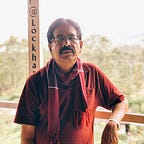SIMPLY SEPULCHRE
My inexplicable fascination to visit during my travels, sepulchres of men of noteworthy reputation, good or wicked history, make me curious to go in search of their final resting places. I had no business to sit on judgement. When the persons are no more we have their tombs to see. Whether it is with devotion or just tourist interest is another matter. What is the famous Shirdi Sansthan sans the tomb ? Our impression is all that matters. Pilgrimage or historical remnants, someone lies buried there, to put it straight. The size of the sepulchre indicates the power of the buried. The Hindu variant for a place of either simple veneration or regular worship is called Samadhi Sthal. We have no dearth of such places.
I have had this peculiar interest since my childhood days. My nephew Kartic used to tease me whenever I stopped to have a closer look at a monument, looking like a tomb of some old type design. All those were in the periphery of the city where we lived.
Some get more importance after their death and those who could afford it, got special architectural structures built over their graves. Generally speaking there will be so much fuss and protocol in visiting a living “God Man” what with his followers making a concerted show of his divinity to inspire the multitudes. Comparatively it is more relaxed and one-sided to pray silently and pass before the tomb when the person concerned is no more. The wall board reassures the devotees that their sincere prayers are answered from the grave. No need to worry when the option is better.
Hence the tombstone is more approachable and taken for granted embodiment. Good for all.
My intention is not to give a list of all the numerous tombs I had visited during my travels marking my observations and making this narrative a tomb travel guide. But if I do not mention a few, the purpose of this writing becomes insipid.
Many years ago when I was in Aurangabad, I asked the hired auto driver Sheikh Masi who was with me one whole day, to take me to the place where the Mughal Emperor Aurangzeb was buried. The low height tomb lies open to the sky with no canopy over it. Located innocuously inside a congested tomb complex some 27 kilometres from Aurangabad, the area was not particularly a spot of tourist interest, unlike his begum’s tomb Bibi ka Maqbara. That was how Aurangzeb wanted it to be.
Some distance near the Ahmednagar Railway Station if we cross the rail track, a walkable steep road takes us to the nearby hill where we find in a small unostentatious stone walled enclosure, the tomb of the “The Silent Master” Meher Baba, the 20th century spiritual figure born to Zoarasrtrian parents. Meher Baba passed away in 1969 leaving behind a major spiritual movement to his followers.
One afternoon, my daughter called from Ooty and informed me that she was on a visit to the hill station with her husband and daughter. I had no previous knowledge of their travel program. The very next morning I sent a detailed message pinpointing the location and urging them to visit the place mentioned by me. It was about the tomb of J.J.Goodwin, the unsung European stenographer of Swami Vivekananda who played a key role in immortalising his lectures. J.J.Goodwin died in 1898 and was buried in the cemetery attached to Saint Thomas Church in Ooty Town. I derived a vicarious satisfaction when my 5 year old granddaughter also visited this place along with her parents.
Lives of great men all remind us
We can make our lives sublime,
And, departing, leave behind us in
Footprints on the sands of time.
— H.W.Longfellow
Tucked inside many enclosed tombs and buildings around, but in a separated open space lies Mazar-e-Ghalib, the grave of Mirza Ghalib, not very far away from Hazrat Nizamuddin Dargah.
Na tha kuch toh Khuda tha, kuch na hota toh Khuda hota, duboya mujhko hone ne, na hota main, toh kya hota.
(When nothing was, then God was there, Had nothing been, God would have been; My being has defeated me, Had I not been, what would have been)
— Ghalib.
Lastly in this account, the visit to Tiruvaiyaru many years ago with family was emotive and exhilarating. It is the place where the 18th-Century Saint Composer Thyagaraja attained Samadhi. It was Bangalore Nagarathnamma, a dedicated soul to music, who was instrumental in erecting a memorial on the banks of the River Cauvery, where his mortal remains were interred.
Tanjore as it was known, was one of the districts in the erstwhile Madras Presidency where the five rivers flowed making the delta fertile for musical devotion. Incidentally it was also the ancestral place of my mother.
Is salvation (moksha) conferred on anyone in this world ?
or is it attainable only to realized souls ?
Is salvation attainable without true devotion in you ?
Can a music-illiterate realize you ?
Thus contemplated Thyagaraja. I felt blessed with my visit.
ESKAYEN
